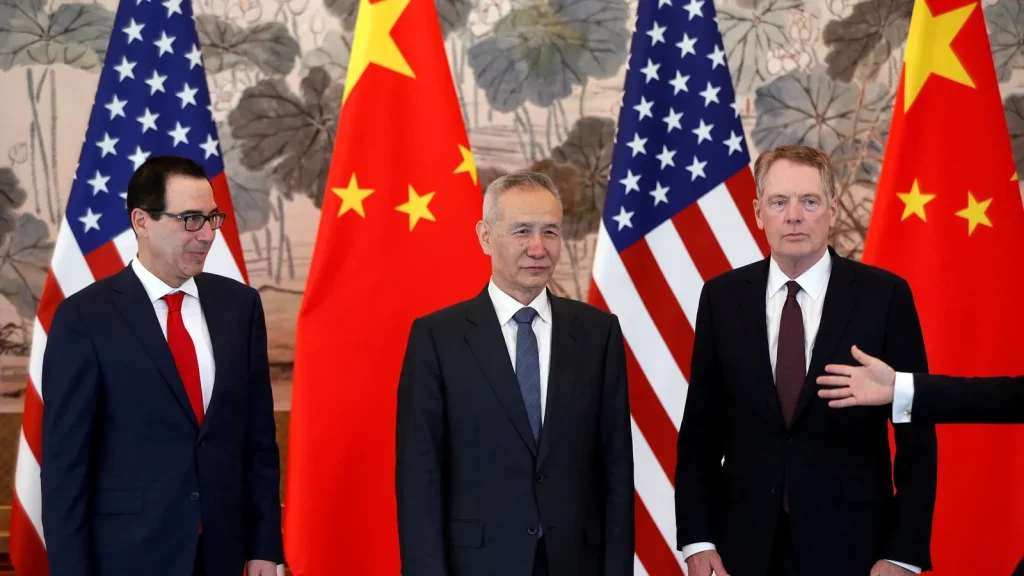U.S.-China trade talks have reached a critical juncture, with renewed urgency for direct communication between the leaders of both nations, according to U.S. Treasury Secretary Scott Bessent. During a recent interview, Bessent emphasized the need for further discussions in the coming weeks, suggesting that a call between President Trump and President Xi Jinping may be imminent. Following a period of escalating trade tensions, the two countries had previously reached a temporary tariff agreement in Switzerland, which was seen as a welcome breakthrough in China-U.S. relations. Despite this progress, underlying issues such as technological restrictions and the handling of rare earth exports remain contentious. Bessent’s optimistic perspective underscores the importance of dialogue in navigating the complexities of these ongoing negotiations, as both nations strive for a more stable economic future.
The dialogue surrounding economic negotiations between the United States and China is more critical than ever, given the complexities involved. Recently, U.S. Treasury Secretary Scott Bessent highlighted the necessity for direct engagement between President Trump and President Xi Jinping to revitalize stalled discussions. With ongoing trade tensions impacting bilateral relations, a recent tariff agreement has offered a temporary reprieve, albeit amid continued friction over technological policies. The intricate nature of these talks necessitates a robust diplomatic approach, as both sides look to reach a sustainable resolution. Thus, fostering China-U.S. relations through open communication remains vital as the two economic powerhouses navigate their intricate relationship.
Status of U.S.-China Trade Talks
Recent comments from U.S. Treasury Secretary Scott Bessent indicate that the ongoing U.S.-China trade talks have hit a stagnation point, requiring leaders from both nations to directly engage in discussions. Bessent noted that more conversations are expected to take place in the coming weeks, potentially involving a call between President Trump and President Xi Jinping. The essential nature of these talks underscores the complex dynamics underlying China-U.S. relations, which have been strained by various tariff disputes and trade restrictions.
While a breakthrough agreement was reached earlier this year during discussions in Switzerland, with both nations agreeing to a temporary rollback of tariffs, tensions persist, particularly concerning technological restrictions imposed by the U.S. on Chinese firms. To mitigate the trade disputes, it is crucial for both leaders to explore new avenues for cooperation and address sticking points, including China’s rare earth export controls and the U.S. sanctions that have drawn Beijing’s ire.
Impact of Trade Tensions on U.S.-China Relations
The escalation of trade tensions between the U.S. and China has significantly impacted bilateral relations, with tariffs on goods reaching unprecedented levels. These tensions have prompted analysts to examine how the evolving trade landscape could influence the relationship between Trump and Xi Jinping. As both nations prepare for potential discussions, the necessity of reaching a sustainable tariff agreement is more critical than ever to avoid further deterioration in diplomatic relations.
Scott Bessent has pointed out that to effectively manage these trade tensions, the U.S. administration must convey its preferences clearly to China. If both leaders can establish an open line of communication, it may create an opportunity for resolving outstanding issues and fostering a more stable trade environment. Ultimately, the success of the upcoming discussions will heavily depend on both sides’ willingness to compromise and address each other’s concerns.
Recent Developments in U.S.-China Trade Relations
Following the tariff halt agreed upon in Switzerland, recent developments suggest that China is still facing challenges in responding to U.S. demands regarding technological and export controls. The actions of the U.S. government concerning visa restrictions for Chinese students have raised further concerns. The Chinese Foreign Ministry has criticized these actions, suggesting they are unjustified and based on ideological grounds. These exchanges underscore the fragile nature of negotiations and how political issues continue to intertwine with trade relations.
While diplomatic efforts are in focus, it is essential for both nations to uphold previously agreed terms and foster an atmosphere of collaboration. The engagement of President Trump and President Xi will be crucial in this regard, with hopes that an upcoming call will clarify expectations and intentions, reducing trade barriers and allowing for enhanced communication. As trade talks continue, the balance of international economic power remains at stake.
The Role of Scott Bessent in Trade Negotiations
Scott Bessent’s involvement in U.S.-China trade talks has been pivotal, as his insights and strategies have played a significant role in navigating the complex landscape of tariffs and trade agreements. His statement about the need for direct communication between the leaders highlights the importance of high-level diplomacy in resolving trade disputes. Bessent’s perspective is vital for understanding the intricacies of trade negotiations and the potential roadblocks both countries face.
With a wealth of experience in international finance, Bessent emphasizes that successful trade relations rely on building trust and addressing mutual concerns. As tensions linger, his guidance will be crucial in ensuring both nations find a workable solution that minimizes the impact of trade tensions on their respective economies. The ability to align interests could pave the way for a more amicable relationship moving forward.
China’s Response to U.S. Trade Policies
China’s reaction to U.S. trade policies has been measured yet assertive, as seen in recent statements by the Chinese Ministry of Commerce. The government has urged the U.S. to correct what it considers to be erroneous practices, particularly concerning export controls and tariff impositions. This insistence on cooperation reflects China’s commitment to maintaining its trade position while protecting its national interests against perceived U.S. aggression.
Additionally, China’s strategic response to technological restrictions highlights the delicate equilibrium needed in U.S.-China relations. By advocating for high-level talks, China aims to reset the dialogue framework, emphasizing the importance of stable trade practices to foster peace and stability in international markets. Ensuring open channels of communication will be vital for both sides as they navigate this challenging economic landscape.
Future of Tariff Agreements Between U.S. and China
The future of tariff agreements between the United States and China hangs in the balance, as both nations weigh their options ahead of anticipated talks. While both sides have demonstrated an inclination to roll back certain tariffs, significant hurdles remain. The ongoing debate over technological restrictions and intellectual property concerns continues to complicate discussions about a more favorable trade environment. There is still uncertainty about how far either side is willing to go to compromise.
Experts stress that any new tariff agreement must consider the broader implications of U.S.-China relations, particularly in light of global economic interdependencies. A sustainable agreement would not only benefit the two economies but could also provide a semblance of stability for international markets that have been affected by these trade tensions. Achieving this requires a nuanced approach, with both leaders needing to navigate their domestic and international pressures.
Impact of Visa Restrictions and Educational Exchanges
The recent move by the U.S. to revoke visas for Chinese students has triggered significant backlash from China, raising concerns about the broader impact on bilateral relations. These educational exchanges are vital not just for the students, but also for fostering goodwill and understanding between nations. Restrictions on academic mobility can hinder the long-term prospects of China-U.S. relations, affecting cooperation in areas beyond trade, such as technology and environmental issues.
Moreover, as both nations navigate through trade discussions, the implications of these visa policies could serve as a stumbling block. Bessent’s insights indicate the need for a comprehensive approach that accommodates concerns on both sides. Addressing educational exchanges may prove to be a critical factor in achieving an overall diplomatic thaw, contributing to a more constructive atmosphere for future negotiations.
Challenges in Achieving Trade Resolutions
Achieving resolutions amid the complexities of U.S.-China trade talks presents numerous challenges. The diverse interests within both nations, from economic stakeholders to political leaders, create a multifaceted negotiation landscape. Anticipating and addressing the core issues, such as tariffs and technology transfers, requires careful coordination and compromise, which can be difficult amidst heightened political sensitivities.
As recent comments from both administrations indicate, the pathway to a mutually beneficial agreement is fraught with potential setbacks. Both leaders must balance domestic pressures and international expectations while steering the discussions towards constructive outcomes. Failure to navigate these challenges could lead to further escalation of tensions, making ongoing dialogue a critical necessity moving forward.
The Significance of High-Level Communication in Trade Talks
High-level communication plays a vital role in the context of U.S.-China trade talks. As indicated by Bessent’s remarks, direct conversations between Trump and Xi Jinping are essential for addressing contentious issues head-on. Diplomatic dialogues at the highest levels can pave the way for resolving misunderstandings and misalignments, allowing for a clearer understanding of each country’s priorities and goals.
Moreover, establishing a routine of such communications could help stabilize the fluctuating nature of their relationship, fostering an environment conducive to ongoing negotiations. By ensuring that both leaders remain engaged, there is a greater likelihood of building a rapport that could lead to substantive agreements. In this volatile economic climate, the importance of high-level dialogue cannot be overstated, as it serves as a barometer for wider diplomatic relations.
Frequently Asked Questions
What is the current status of U.S.-China trade talks?
As of now, U.S.-China trade talks are described as “a bit stalled”. U.S. Treasury Secretary Scott Bessent indicated that ongoing discussions between the leaders of the two nations are necessary to break the deadlock.
How have recent trade tensions affected U.S.-China relations?
Recent trade tensions have led to increased tariffs and restrictions from both sides, impacting the diplomatic and economic relations within U.S.-China relations. However, a breakthrough agreement was reached in May, rolling back some tariff increases.
What role did Scott Bessent play in the U.S.-China trade talks?
Scott Bessent has been instrumental in facilitating discussions between the U.S. and China, helping to achieve a significant agreement in Switzerland that aims to ease trade tensions and reduce tariffs for a limited timeframe.
Are there any recent agreements between the U.S. and China regarding tariffs?
Yes, the U.S. and China reached an agreement in May to roll back recent tariff increases for 90 days. This agreement aims to reduce trade tensions between the two nations and foster discussions moving forward.
What are the expectations for future U.S.-China trade talks?
Future U.S.-China trade talks are anticipated to involve direct communication between President Trump and President Xi Jinping, as emphasized by Scott Bessent. Both leaders’ engagement is crucial considering the complexity and scale of the ongoing negotiations.
How have technological restrictions impacted trade relations between the U.S. and China?
The U.S. has imposed technological restrictions on China, leading to significant frustration from Beijing. These restrictions continue to complicate the trade relationship, despite both nations attempting to maintain open communication.
What is China’s response to U.S. trade policies regarding rare earths?
China has consistently urged the U.S. to rectify what it describes as wrong practices, particularly in relation to rare earth export controls. China maintains that its restrictions align with international practices aimed at ensuring peace and stability.
What have been the implications of recent actions taken by the U.S. administration towards Chinese students?
The Trump administration’s decision to revoke visas for Chinese students has been criticized by China’s Foreign Ministry as “unjustified.” This action highlights the ongoing tensions and ideological conflicts influencing U.S.-China relations.
When did Trump and Xi last communicate about trade issues?
President Trump and President Xi Jinping last engaged in direct communication in January before Trump’s second term inauguration. Analysts suggest that future discussions will only take place if both sides are assured of stable terms.
What are the key outcomes expected from upcoming U.S.-China calls?
Upcoming calls between U.S. and Chinese leaders are expected to address the complexities of trade agreements, reaffirm communication, and ideally lead to agreements that alleviate the current trade tensions.
| Key Point | Details |
|---|---|
| U.S.-China Trade Talks Status | Currently stalled; direct communication between leaders is required. |
| Recent Developments | A breakthrough agreement was reached on May 12, rolling back tariffs for 90 days. |
| Ongoing Tensions | The U.S. has imposed technological restrictions and China has not eased rare earth restrictions. |
| Future Engagement | Bessent emphasized the need for both leaders to engage, with hopes for future discussions. |
| China’s Position | China maintains communication but demands corrections to U.S. practices, especially regarding chip controls. |
| Visa Issues | The U.S. plans to revoke visas for Chinese students, which China calls unjustified. |
Summary
The U.S.-China trade talks are currently at a standstill, necessitating direct communication between the leaders of both nations. On Thursday, U.S. Treasury Secretary Scott Bessent highlighted the complexity of the negotiations and the need for renewed dialogue. While a recent agreement has momentarily eased some trade tensions, ongoing issues, particularly regarding technology restrictions and rare earth exports, remain unresolved. Ensuring effective communication between Presidents Trump and Xi Jinping could be crucial for future progress, especially against the backdrop of rising strategic concerns on both sides.



